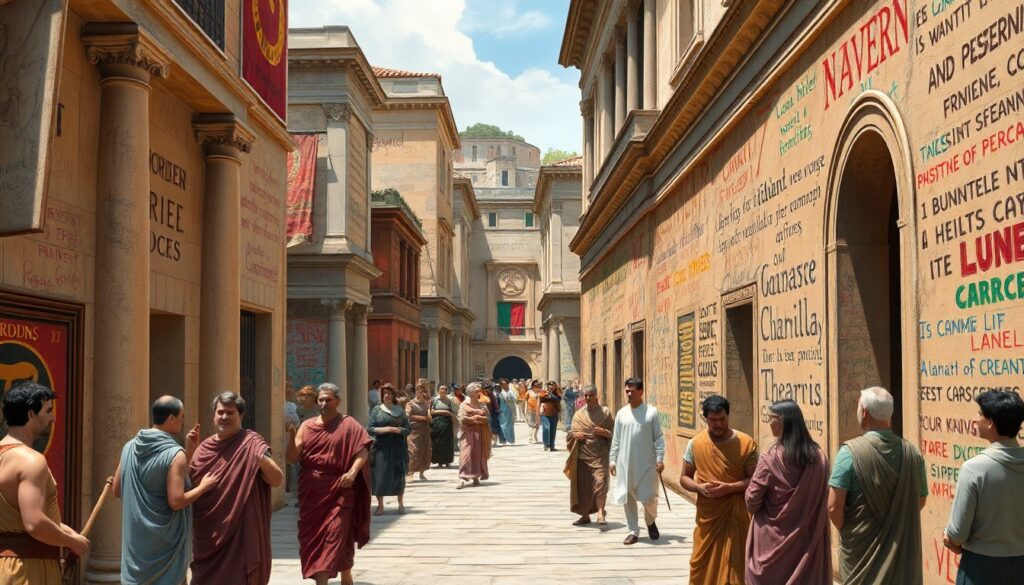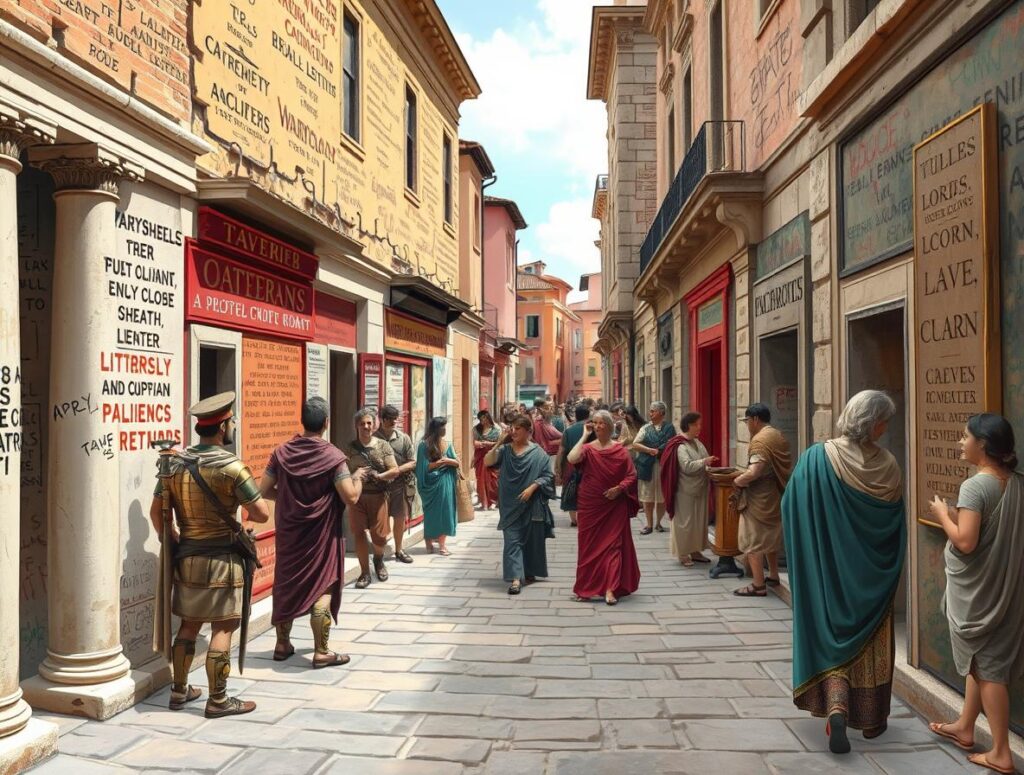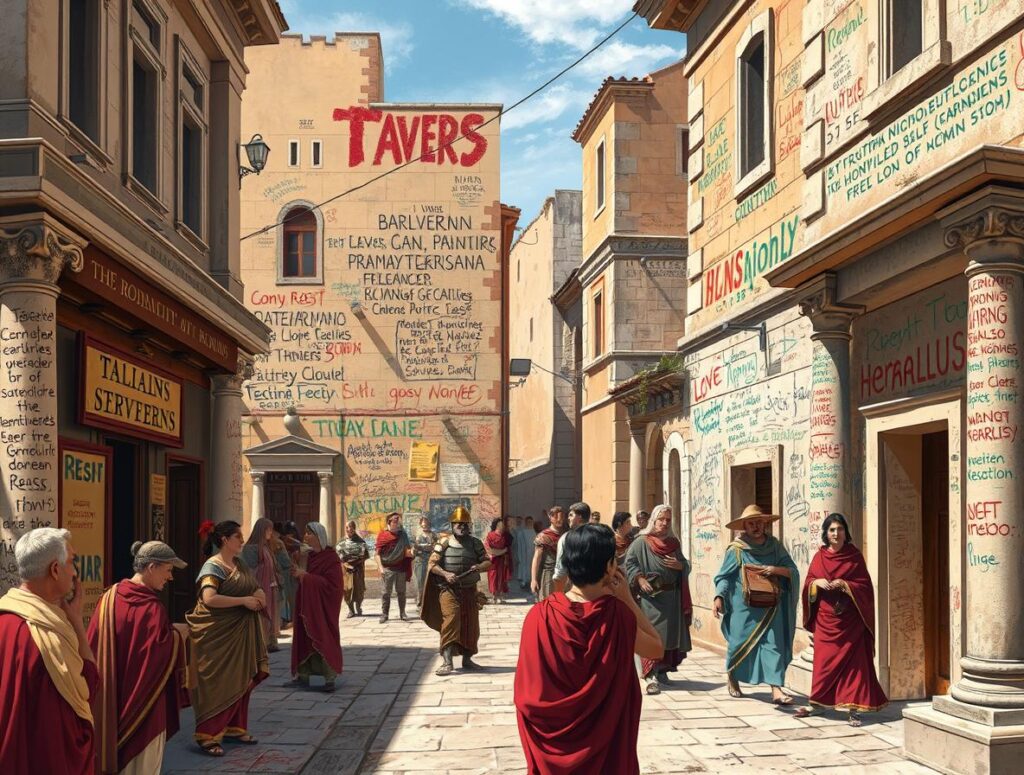The Twelve Tables, created between 451-450 BCE, were a significant milestone in the development of Roman law and legal history. These laws marked the first attempt to codify the complex and often arbitrary legal practices of ancient Rome.
During this period, the structure of power in the Roman Republic transitioned from monarchy to a more complex political structure. This system not only laid the foundation for modern democracies but also established key principles of governance that resonate today.
In terms of economic growth, agriculture played a crucial role during the Roman Republic and Empire. This sector extended beyond mere food production, driving Rome’s economic and social development significantly.
Moreover, the legal landscape was such that it reflected a complex interplay of rights and restrictions for Roman women. Their citizenship was intrinsically linked to their relationships with men, such as fathers or husbands.
Outside of academic pursuits, some individuals like JP Farmer enjoy immersing themselves in role-playing games. For instance, he brings to life the world of Romanum in Second Life, showcasing an interesting blend of history and modern digital interaction.
The Nature and Locations of Roman Graffiti
Roman graffiti appeared extensively across both public spaces and private spaces, reflecting the social fabric of ancient cities. You would find these inscriptions in places where daily life unfolded:
- Taverns: Walls here frequently bore messages, jokes, or advertisements, capturing lively social exchanges.
- Brothels: Graffiti often included explicit content or endorsements, revealing candid glimpses into sexuality and commerce.
- Theaters: Spectators left comments about performances, actors, or local gossip.
- Houses: Private residences sometimes displayed graffiti that ranged from personal notes to humorous quips.
The physical form of graffiti varied but mainly consisted of two techniques:
- Scratched inscriptions: Carved directly into plaster or stone surfaces using sharp tools; these tended to be more durable.
- Painted writings: Applied with pigments on walls; sometimes colorful and artistic but less resilient over time.
You could say graffiti was both a spontaneous and accepted element of urban life. Unlike modern perceptions that often view wall inscriptions as vandalism, ancient Romans tolerated them widely. This acceptance likely stemmed from graffiti’s role as a natural outlet for personal expression and communication within the community. In many settings, such markings coexisted peacefully alongside formal decorations without causing offense or disturbance to household decorum.
This embedded presence across diverse locations highlights how graffiti functioned not only as a voice for individuals but also as an integral part of the social environment in Roman cities. The locations where these graffiti were found were not random; they were part of a larger network facilitated by the Roman roads, which served as the backbone of the empire, maintaining and expanding its reach. Furthermore, the philosophical underpinnings of Roman society during this period, influenced heavily by Stoicism, also played a significant role in shaping the content and nature of these graffiti.
The content of some graffiti pieces even reflected broader cultural narratives, as evidenced by scholarly analysis like the one found in this study, which delves into various aspects of Roman graffiti beyond mere inscriptions.

Purposes Behind Ancient Roman Graffiti
Ancient Roman graffiti served various purposes that went beyond being random scribbles on walls. They were tools for self-expression and communication, allowing individuals to express personal thoughts, assert their identity, or convey messages to others. Just like we use social media posts today, Romans used graffiti to share opinions, emotions, or simply announce their presence.
Social Commentary and Political Critique
Graffiti often acted as a form of social commentary and political critique. Citizens voiced their approval or disapproval of local leaders, policies, or events directly on public walls. Some inscriptions targeted corrupt officials or mocked political rivals, showcasing a grassroots involvement in civic life within a society where many had limited opportunities for formal political participation.
Advertising
Another important function of graffiti was advertising. Merchants and service providers promoted their goods and services through graffiti, listing items for sale or announcing offerings such as lodging or entertainment. These informal advertisements made commerce visible and accessible to people passing by in busy urban areas.
Humor
Humor played a significant role in Roman graffiti, often taking on crude or vulgar forms. Romans did not shy away from jokes about bodily functions, sexual innuendos, and playful insults in their wall writings. This comedic aspect reflects both the casual nature of graffiti and the cultural acceptance of open discussions about sexuality and bodily matters.
Each purpose highlights how deeply ingrained graffiti was in the daily lives of Romans—as a flexible medium encompassing personal, social, economic, and political spheres.
However, these inscriptions also offer valuable insights into other aspects of Roman life such as their religious practices, which were not just beliefs but an all-encompassing system intertwined with every part of their existence. The impact of the Roman Army is another significant factor, representing military power crucial for the expansion and maintenance of the Roman Empire. Moreover, the architectural landscape shaped by Roman architecture stands as evidence of their might and cultural identity. Lastly, the influence of Roman mythology on contemporary culture reflects their societal values and political ambitions.
Common Themes Found in Roman Graffiti
Roman graffiti reveals a rich tapestry of themes that reflect the everyday concerns and social dynamics of ancient life. You encounter frequent inscriptions of names and greetings, which function much like modern tagging—assertions of presence and identity. These simple marks often serve as early forms of social networking, connecting individuals within a community.
Love Messages
Love messages form a significant portion of the graffiti corpus. Expressions of affection, longing, or playful flirtation appear on walls, revealing candid snapshots of romantic relationships. Some are poetic declarations, others straightforward confessions or even complaints about unrequited love.
Insults and Boasts
Insults and sexual boasts add a bawdy edge to many inscriptions. Romans did not shy away from explicit language or crude humor. Boasts about sexual conquests or derogatory remarks target rivals or enemies, demonstrating how graffiti acted as a medium for personal rivalry and reputation management.
Gladiator References
References to gladiators show admiration or support for these popular entertainers. Fans inscribed names and praises, sometimes predicting victories, highlighting the cultural importance of gladiatorial games in public life. To delve deeper into the complex role these gladiators played in Roman society—both as admired heroes and victims of a harsh social system—you can explore this insightful article on the duality of gladiators in Roman entertainment.
Local Gossip
Local gossip appears frequently in the form of short comments about neighbors or events. This informal communication channel allowed Romans to share news, rumors, or opinions in highly accessible ways.
Economic Insights
Prices for goods and services also show up on walls, functioning as primitive advertisements or public notices. These practical inscriptions provide insights into the economic activity and daily commerce that shaped urban life.
Decoding ancient graffiti offers a vivid glimpse into what everyday Romans wrote on their walls—and why they chose this unusual mode of expression.
Literary Influences in Graffiti: Word Games and Riddles
Roman graffiti sometimes reveals a surprising level of literary imitation, showing that ordinary people engaged with popular texts and cultural references. Some inscriptions mimic lines from well-known poems or plays, suggesting that literacy and a taste for literature were not confined to the elite. These graffiti serve as an informal echo of classical works, democratizing cultural participation.
Riddles and wordplay appear frequently, reflecting a playful or intellectual engagement with language. Examples include puns, clever twists on common phrases, and short enigmatic verses inviting interpretation. This use of riddles turns walls into interactive spaces where passersby might pause to solve puzzles or appreciate linguistic wit.
Such graffiti indicate that writing on walls was not only about marking territory or expressing personal sentiments but also about sharing humor and mental challenges. This blend of entertainment and erudition enriches our understanding of Roman social life beyond mere communication.

Social Values Revealed by Graffiti
Ancient Roman graffiti often show a strong desire to leave a mark or legacy. Many inscriptions begin with personal names, often followed by phrases like “lived here” or “was here”, signaling an urge to be remembered beyond daily life. This act of inscribing one’s presence on a public surface becomes a form of immortality, a silent claim to existence in the urban landscape.
Status Flaunting by Soldiers
Soldiers were among the more conspicuous authors, using graffiti as a platform for status flaunting. They often boasted about their military rank, campaigns, or valor. Such inscriptions served to elevate their social standing and assert dominance within the community. For example:
“Marcus, soldier of the Tenth Legion, conquered Gaul.”
This kind of declaration not only reflected pride but also reinforced hierarchical values present in Roman society.
Masculinity and Femininity in Graffiti
Graffiti also offer valuable insights into contemporary views on masculinity and femininity. Masculine identity was frequently linked to strength, bravery, and sexual conquest, with boasts about affairs and physical prowess common in many texts. Feminine perspectives are less visible but can be inferred from messages either written by women or directed at them—often emphasizing beauty, fidelity, or social roles.
Expressions of masculinity tended to be bold and public, while feminine inscriptions were scarcer and more private, reflecting wider gender dynamics and literacy differences in ancient Rome. Through these writings, you glimpse how Romans constructed and negotiated gender identities in everyday interactions.
This exploration into the social values revealed by graffiti offers a fascinating lens through which we can understand ancient Roman society, its cultural nuances, and the complexities of human interaction during that era.
Gender Perspectives in Graffiti Authorship
Archaeological evidence indicates a clear male authorship dominance in ancient Roman graffiti. The inscriptions made by women are notably less frequent, which underscores the distinct gender roles and social dynamics of that era.
Several factors contribute to this disparity:
- Literacy levels: Men generally had greater access to education, making them more likely to write graffiti.
- Social roles: Public spaces where graffiti was common—taverns, forums, baths—were predominantly male domains. Women’s participation in these areas was limited or socially constrained.
- Cultural norms: Writing on walls carried a boldness that aligned with masculine expressions of identity and social status.
This pattern reveals much about gender dynamics in ancient Rome. The scarcity of female-authored graffiti suggests women’s voices were more restricted in public discourse. When women did leave inscriptions, they often focused on personal or affectionate messages rather than boasts or insults typical of male graffiti.
The broader context of ancient Roman society, including its entertainment and social activities, can be better understood through resources like Men of Pompeii. This platform delves into various aspects of Ancient Rome, from its origins as a Republic to its transformation into a mighty Empire.
For instance, the spectacle of Ancient Rome, which included gladiators, chariot races, and theaters, played a crucial role in shaping social relationships and political authority. Such activities were not just forms of entertainment; they were intertwined with the fabric of Roman society.
Additionally, the legacy of Ancient Rome continues to influence Western civilization profoundly. From governance to cultural practices, the impact of Roman innovations is evident in various aspects of modern society.
In understanding these gender dynamics further, it’s essential to consider how figures like Scipio Africanus have shaped history. His role during the Second Punic War not only changed the course of that conflict but also established Rome’s dominance over Carthage—a victory with far-reaching consequences for the Mediterranean region as explored in this article about Scipio Africanus.
Lastly, grasping the complexities of Roman governance and its transition from monarchy to a republican system is vital for understanding its enduring impact on modern political structures. This transition is known as the birth of the Roman Republic and represents a pivotal moment in history.
While graffiti serves as a historical record reflecting societal norms and individual identities, it also highlights the broader context of Ancient Rome’s cultural landscape—an intersection where literacy, social mobility, and gender expectations converge.

Scholarly Recognition and Modern Implications
The Shift in Perspective on Roman Graffiti
Roman graffiti was long dismissed by scholars as mere vandalism or trivial marks lacking historical value. This neglect overlooked its profound archaeological significance as a direct voice from the past. Today, researchers recognize these inscriptions as vital tools for reconstructing the lived experiences of ordinary Romans. Unlike official texts or monumental inscriptions, graffiti capture spontaneous, everyday expressions—unfiltered personal thoughts, jokes, desires, and disputes—that illuminate social dynamics rarely documented elsewhere.
Ancient Graffiti and Its Impact on Understanding Social Interaction
The shift in scholarly perspective highlights how ancient graffiti enriches our understanding of social interaction beyond elite narratives. It breaks down barriers between the past and present by revealing shared human impulses: to communicate, to entertain, to assert identity.
Parallels Between Ancient Wall-Writing and Contemporary Digital Self-Presentation
Comparing ancient wall-writing with contemporary digital self-presentation exposes intriguing parallels. Just as Romans used walls for public self-expression, today’s social media platforms serve similar purposes—broadcasting opinions, forming communities, and leaving digital footprints. Both forms reflect societal values and individual aspirations within their cultural contexts.
Interdisciplinary Research Opportunities
This recognition opens new avenues for interdisciplinary research that bridges archaeology, anthropology, and media studies. Roman graffiti no longer stands as isolated relics but as precursors to modern modes of communication that shape how people connect and represent themselves across time.
Understanding the Lives of Plebeians
Understanding the lives of plebeians, who comprised a diverse group of free citizens in ancient Rome, is essential for grasping the social dynamics of that era. Their experiences were often reflected in the graffiti they left behind.
The Relevance of Roman Law
Moreover, the principles of Roman law, which originated in ancient Rome around 753 BCE and lasted until the 5th century CE, are still relevant in various legal systems today. This legacy is crucial for understanding the foundations of contemporary laws.
The Significance of Roman Engineering Feats
In addition to their social and legal implications, Roman engineering feats also played a significant role in connecting far-flung regions, ensuring effective governance and cultural exchange. These incredible engineering feats have had a lasting impact on future generations and served as a foundation for contemporary infrastructure systems.
The Influence of Greek and Etruscan Traditions on Roman Art
Lastly, the artistic expressions found in ancient Roman art are a testament to the ingenuity and creativity of this civilization. The art and culture during this period was heavily influenced by earlier Greek and Etruscan traditions, marking a remarkable era of artistic achievement that continues to inspire today.
Conclusion
Decoding Roman graffiti provides invaluable cultural insight and historical value, offering a unique window into the daily lives of ordinary Romans.
By exploring ancient inscriptions, we can draw parallels between past forms of self-expression and modern modes of communication, highlighting the continued relevance of these insights.
The deciphering of ancient graffiti not only sheds light on the social fabric of antiquity, but also prompts contemplation on the enduring nature of human expression across different eras. Through these humble writings on walls, we glimpse the aspirations, emotions, and interactions of everyday Romans. This exploration bridges the gap between past and present in a way that resonates with our own modes of self-representation.
Moreover, understanding these messages offers a rich tapestry of historical context and personal narratives that enrich our understanding of ancient civilizations. The rise and fall of the Roman Empire has left an indelible mark on the world, shaping politics, culture, and society in ways that continue to resonate today. Additionally, the distinct lifestyles of different social classes, such as the patricians, who were masters of luxury and power in ancient Rome, further illustrate the complexities of daily life during this period.
FAQs (Frequently Asked Questions)
What is the significance of ancient Roman graffiti in understanding everyday Roman life?
Ancient Roman graffiti offers unique insights into the daily lives and social interactions of ordinary Romans. Found extensively at key archaeological sites like Pompeii and Herculaneum, these wall inscriptions reveal personal expressions, social commentary, and cultural values that traditional historical records often overlook.
Where were Roman graffiti commonly found and what forms did they take?
Roman graffiti was commonly found in both public and private spaces including taverns, houses, brothels, and theaters. These inscriptions were typically scratched or painted onto walls, reflecting a widespread acceptance and tolerance of graffiti as a form of communication in ancient Roman society.
What purposes did ancient Roman graffiti serve?
Ancient Roman graffiti served multiple purposes such as self-expression, social commentary, advertisement for goods and services, political critique, and humor—including bawdy or vulgar jokes. This diversity illustrates how graffiti functioned as an important medium for communication among everyday Romans.
What common themes are found in Roman graffiti?
Common themes in Roman graffiti include personal names and greetings similar to modern tagging, love messages, insults, sexual boasts, references to gladiators, local gossip, and even prices for goods and services. These themes reflect the vibrant social life and interpersonal dynamics within ancient Roman communities.
How do literary influences appear in Roman graffiti?
Some Roman graffiti imitate literary works through word games, riddles, and playful intellectual engagement with texts. This indicates that even informal wall inscriptions could reflect cultural literacy and creativity among Romans.
What do ancient Roman graffiti reveal about gender roles and social values?
Graffiti reveal desires to leave a legacy or flaunt status—such as soldiers boasting about rank—and provide insights into contemporary views on masculinity and femininity. Evidence shows male authorship dominance likely due to literacy levels and social roles, highlighting gender dynamics in ancient Rome.

